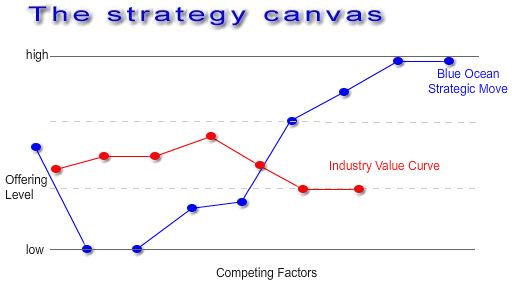 |
Blue Ocean Strategy (BOS) is a book published in 2005 and written by W. Chan Kim and Renée Mauborgne, Professors at INSEAD and Co-Directors of the INSEAD Blue Ocean Strategy Institute. This book is based on studies over 150 strategic moves in various industries. basically it is about to drawn away from the bloody red oceans and enter the blue oceans. The authors explain how to swim in the blue ocean by firstly draw your company's Strategy canvas then apply the 4 Actions Framework.
Red ocean companies try to outperform their rivals to grab a greater share of existing demand. As the market space gets crowded, prospects for profits and growth reduce. Products become commodities and cut throat competition turns the ocean bloody red.
Blue oceans in contrast, are defined by untapped market space, demand creation, and the opportunity for highly profitable growth. Most are created from within red oceans by expanding industry boundaries. In blue oceans, competition is irrelevant. Yes, imitators arise, but experience shows there is a wide window of opportunity to stay ahead of imitators.
 |
| RED vs BLUE |
The Strategy Canvas
The strategy canvas is both a diagnostic and an action framework for building a compelling BOS. The horizontal axis captures the range of factors that the industry competes on and invests in, while the vertical axis captures the offering level that buyers receive across all of these key competing factors.
The strategy canvas serves two purposes:
• To capture the current state of play in the known market space, which allows users to clearly see the factors that the industry competes on and where the competition currently invests and
• To propel users to action by reorienting focus from competitors to alternatives and from customers to noncustomers of the industry
The value curve is the basic component of the strategy canvas. It is a graphic depiction of a company’s relative performance across its industry’s factors of competition. A strong value curve has focus, divergence as well as a compelling tagline.

4 Actions Framework
The Four Actions Framework is used to reconstruct buyer value elements in crafting a new value curve. To break the trade-off between differentiation and low cost and to create a new value curve, the framework poses four key questions, shown in the diagram, to challenge an industry’s strategic logic.
Six Principles in Creating and Executing a Blue Ocean Strategy
1. Reconstruct Market Boundaries
2. Focus on the Big Picture, not the Numbers
3. Reach Beyond Existing Demand
4. Get the Strategic Sequence Right
5. Overcome Key Organizational Hurdles
6. Build Execution into Strategy
 |
| 6 Principles of BOS |
10 Key Points about Blue Ocean Strategy
BOS is the result of a decade-long study of 150 strategic moves spanning more than 30 industries over 100 years (1880-2000).
- BOS is the simultaneous pursuit of differentiation and low cost.
- The aim of BOS is not to out-perform the competition in the existing industry, but to create new market space or a blue ocean, thereby making the competition irrelevant.
- While innovation has been seen as a random/experimental process where entrepreneurs and spin-offs are the primary drivers – as argued by Schumpeter and his followers – BOS offers systematic and reproducible methodologies and processes in pursuit of blue oceans by both new and existing firms.
- BOS frameworks and tools include: strategy canvas, value curve, four actions framework, six paths, buyer experience cycle, buyer utility map, and blue ocean idea index.
- These frameworks and tools are designed to be visual in order to not only effectively build the collective wisdom of the company but also allow for effective strategy execution through easy communication.
- BOS covers both strategy formulation and strategy execution.
- The three key conceptual building blocks of BOS are: value innovation, tipping point leadership, and fair process.
- While competitive strategy is a structuralist theory of strategy where structure shapes strategy, BOS is a reconstructionist theory of strategy where strategy shapes structure.
- As an integrated approach to strategy at the system level, BOS requires organizations to develop and align the three strategy propositions: value proposition, profit proposition and people proposition.
Reference
http://www.blueoceanstrategy.com/

No comments:
Post a Comment